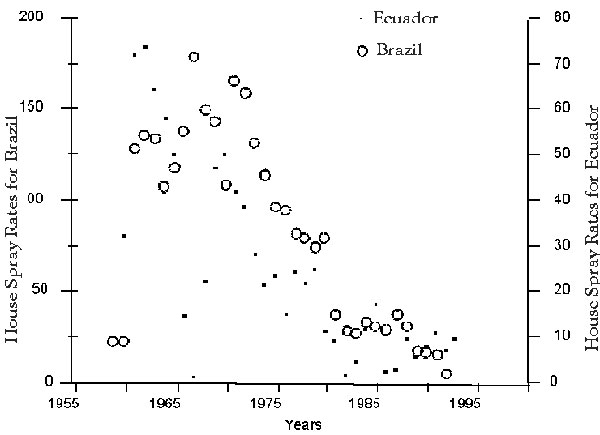Volume 3, Number 3—September 1997
Perspective
DDT, Global Strategies, and a Malaria Control Crisis in South America
Figure 6

References
- World Health Organization. Implementation of the global malaria control strategy. World Health Organ Tech Rep Ser 1993; no. 839.
- Pan American Health Organization. Status of malaria programs in the Americas. XLIII Report. Washington (DC): PAHO; 1995.
- Pan American Health Organization. Status of malaria programs in the Americas. XLIV Report. Washington (DC): PAHO; 1996.
- Pan American Health Organization. Status of malaria programs in the Americas. XLII Report. Washington (DC): PAHO; 1994.
- Pan American Health Organization. Status of malaria programs in the Americas. XL Report. Washington (DC): PAHO; 1991.
- World Health Organization. Sixth Report, Expert Committee on Malaria. World Health Organ Tech Rep Ser 1957; No. 123.
- Brown AWA, Haworth J, Zahar AR. Malaria eradication and control from a global standpoint. J Med Entomol. 1976;13:1.PubMedGoogle Scholar
- Gilles HM, Warrell DA. Bruce-Chwatt's essential malariology. Boston: Edward Arnold; 1993.
- World Health Organization. Seventeenth Report, WHO Expert Committee on Malaria. World Health Organ Tech Rep Ser 1979; No. 640.
- World Health Organization. Resistance of vectors of disease to insecticides. World Health Organ Tech Rep Ser 1980; No. 655.
- Roberts DR, Andre RG. Insecticide resistance issues in vector-borne disease control. Am J Trop Med Hyg. 1994;50:21.PubMedGoogle Scholar
- Roberts DR, Alecrim WD. Behavioral response of Anopheles darlingi to DDT-sprayed house walls in Amazonia. Bull Pan Am Health Organ. 1991;25:210–7.PubMedGoogle Scholar
- Rozendaal JA. Behavioral responses of Anopheles darlingi in Suriname to DDT residues on housewalls. J Am Mosq Control Assoc. 1989;5:351–8.PubMedGoogle Scholar
- Pan American Health Organization. PAHO Environmental Series. 1993;12:53.
- Agricultural Stabilization and Conservation Service. Pesticide review. United States Department of Agriculture; 1968.
- Arellano F. Uso de insecticidas en el programa de control de la malaria del Ecuador. Estrategia aconsejada. In: Comité Rotario Interdistrital Andino de Lucha Contra la Malaria, editors. Nuevas estrategias contra la malaria. Quito, Ecuador: Rotario Interdistrital Andino de Lucha Contra la Malaria; 1990.
- Bruce-Chwatt LJ. The cost of malaria and of its control in relation to socio-economic realities. In: Study Group on Malaria in the Americas, editors. Washington (DC): Pan American Health Organization, 1977.
- Pan American Health Organization. Empleo de insecticidas en salud pública Estados Unidos Mexicanos, 1957-1987. In Proceedings of "Taller sobre resistance," PAHO meeting 1988 18-29 Julio, Guatemala.
- Gahan JB, Travis BV, Morton FA, Lindquist AW. DDT as a residual-type treatment to control Anopheles quadrimaculatus, practical tests. J Econ Entomol. 1945;38:223–35.
1This percentage was obtained by adding the number of slides from passive case detection reports and from voluntary collaborators and then dividing the sum by the number of slides acquired through active case detection.
2Statistics drawn from a U.S. Agency for International Development review in 1973-1974 of the malaria eradication program in Brazil and based on regions that were in the attack phase. There was greater reliance on active and epidemiologic surveys in such areas than in areas of consolidation or maintenance. Therefore, the overall percentage of slides derived from passive case detection was undoubtedly higher than 35%.
3The Commission for Environmental Cooperation (CEC) is a North American environment commission established by a North American Free Trade Agreement side agreement. The CEC draft agreement entitled "North American Regional Action Plan on DDT, Task Force on DDT and Chlordane," dated October 10, 1996, calls for the elimination, distribution, and use of DDT for malaria control in Mexico in 10 years.
4Recommended weekly treatments of 0.9-1.36 kg (2-3 pounds) of DDT per 0.004 km2 (1 acre) of cotton. Using a 7-week period and a treatment of 1.13 kg (2.5 pounds) per 0.004 km2, 340 kg (1.750 pounds) of DDT is required for 0.4 km2 (100 acres) of cotton.
5World Health Assembly document A31/19, 1978.